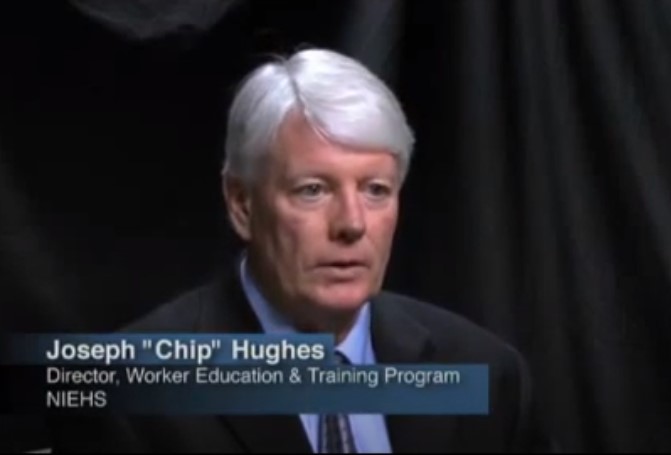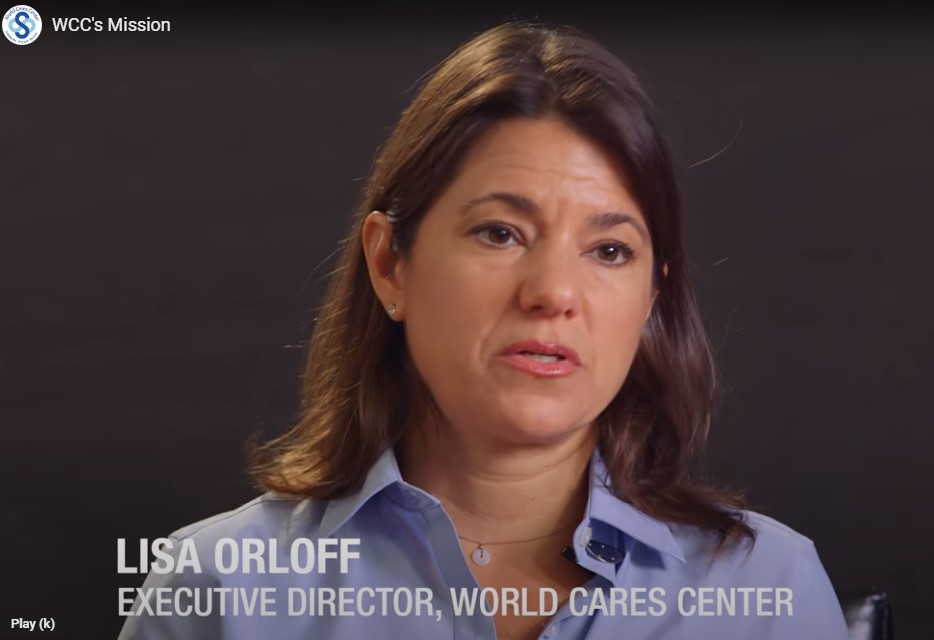ECWTP Timeline & Key Events
1978
- Love Canal Toxic Dump Declared Emergency
-
August 1978
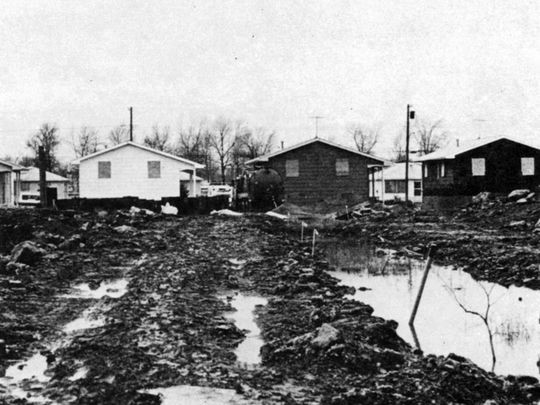 Remediation work being done near abandoned houses in the Love Canal neighborhood in the late 1970s. (Photo courtesy of the Center for Health, Environment, & Justice)
Remediation work being done near abandoned houses in the Love Canal neighborhood in the late 1970s. (Photo courtesy of the Center for Health, Environment, & Justice)President Jimmy Carter declared the Love Canal toxic dump a federal health emergency.
For decades, the canal served as a municipal and industrial chemical dumpsite. In early 1978, the canal exploded, triggered by a record amount of rainfall in the area. Shortly after, hazardous chemicals began leaching into the soil and basements of nearby homes and a public school built near the site. Exposure to these chemicals led to several adverse health effects in nearby residents. The federal government provided financial aid to relocate hundreds of families.
Related Links:
- The Love Canal Tragedy, U.S. Environmental Protection Agency Archive
- Love Canal and Its Mixed Legacy, The New York Times
1980
- Comprehensive Environmental Response, Compensation, and Liability Act
-
December, 1980
Recognizing the threat posed by dangerous chemicals and other pollutants left in toxic waste dumps nationwide, U.S. Congress passed the Comprehensive Environmental Response, Compensation, and Liability Act (CERCLA, or Superfund). This law provided federal authority to respond directly to potential and hazardous substance releases that may endanger public health or the environment.
Related Links:
1982
- Warren County, NC Protest Landfill Construction
-
September 1982
Residents of Warren County, North Carolina protest construction of hazardous waste landfill in a predominantly African-American community. This was the start of the Environmental Justice movement.
Clips from the Warren County protest are featured in the video, “When Environmental Justice Meets Human Rights,” along with perspectives from Robert Bullard, Ph.D., a long-time advocate for environmental justice and co-lead for ECWTP grantee the Historically Black Colleges and Universities Consortium.
Related Links:
- Carolinians Angry Over PCB Landfill, The New York Times
1986
- Superfund Amendments and Reauthorization Act
-
October 1986
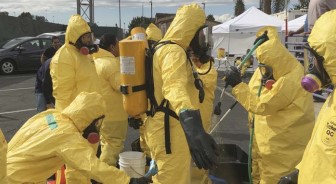 Training exercise conducted by WTP grantee the Western Region Universities Consortium (Photo courtesy of the Western Region Universities Consortium))
Training exercise conducted by WTP grantee the Western Region Universities Consortium (Photo courtesy of the Western Region Universities Consortium))U.S. Congress passed the Superfund Amendments and Reauthorization Act (SARA) as an amendment to the 1980 CERCLA. The NIEHS Worker Training Program (WTP) was established under SARA, Section 126g, authorizing training and education of workers engaged in activities related to hazardous materials and waste removal and clean-up, as well as emergency response.
1987
- Toxic Wastes and Race Report
-
April 1987
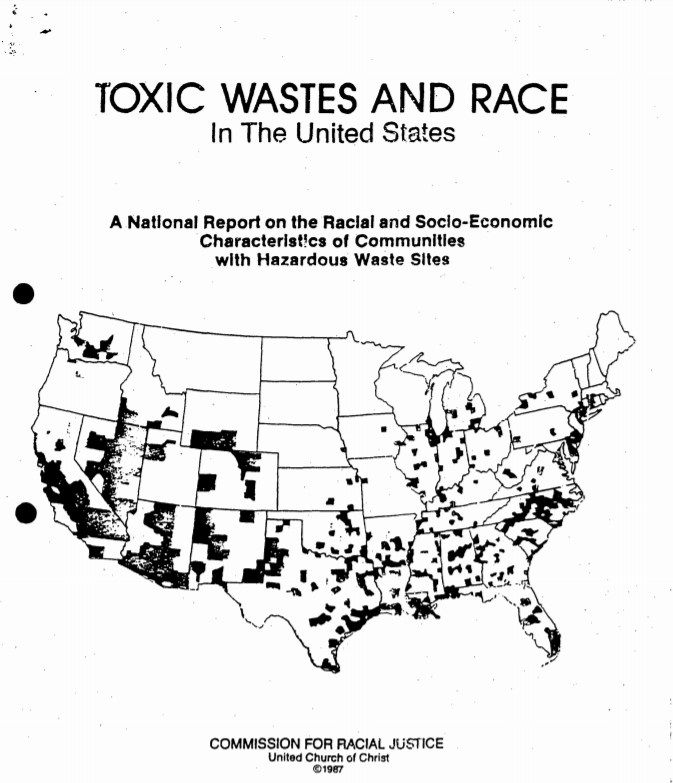 Toxic Wastes and Race Report
Toxic Wastes and Race ReportIn 1987 the United Church of Christ's Commission for Racial Justice published its landmark report Toxic Wastes and Race in the United States. The report documented disproportionate environmental burdens facing people of color and low-income communities across the country.
- NIEHS Worker Training Program (WTP)
-
September 1987
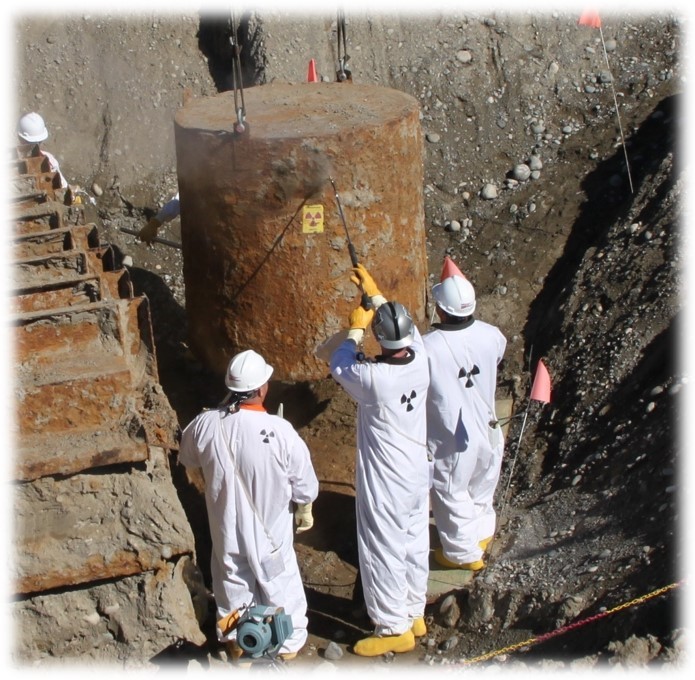 Photo of workers at a Department of Energy site. (Photo courtesy of WTP)
Photo of workers at a Department of Energy site. (Photo courtesy of WTP)WTP awarded its first set of grants to 15 institutions and labor-based health and safety organizations across the country. WTP grants are unique compared to other NIEHS grants, in that they are based on cooperative agreements. Grantees are committed to providing occupational safety and health training for workers who may be engaged in hazardous waste removal, environmental cleanup activities, or emergency response.
Related Links:
1991
- Environmental Justice Summit
-
October 24-27, 1991
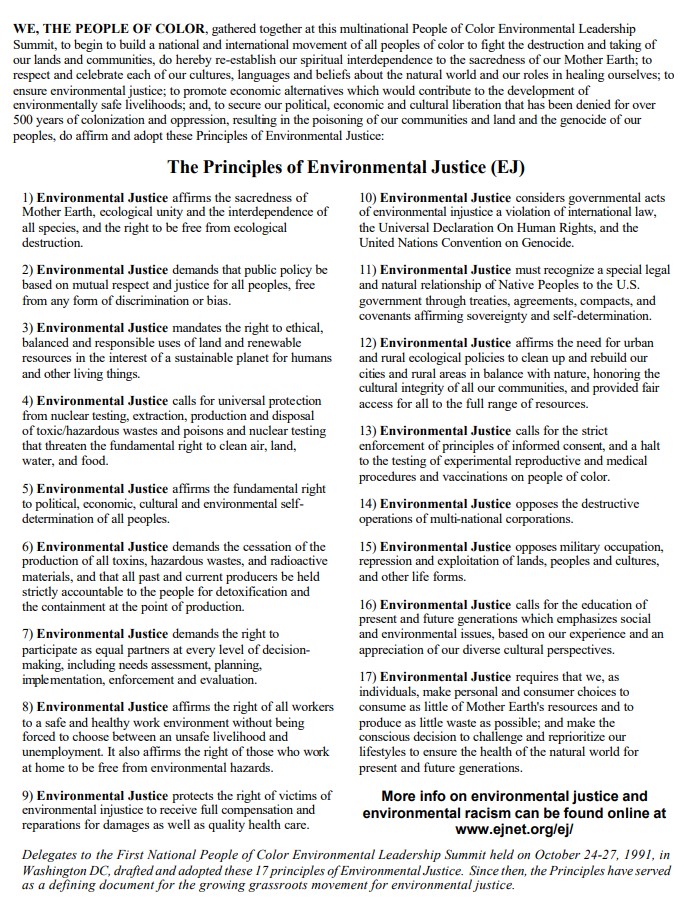
Delegates to the First National People of Color Environmental Leadership Summit held in Washington D.C., drafted and adopted 17 principles of Environmental Justice. Since then, The Principles have served as a defining document for the growing grassroots movement for environmental justice.
1993
- Brownfields Redevelopment Initiative
-
September 1993
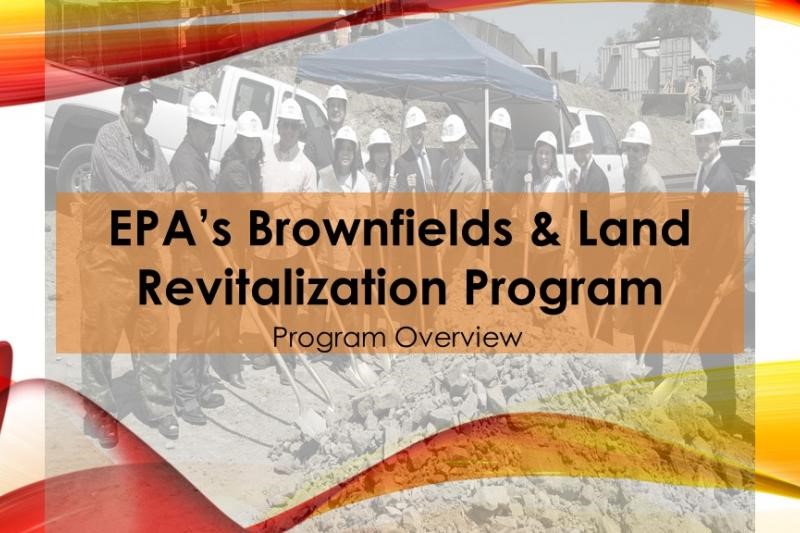 Photo courtesy of the U.S. Environmental Protection Agency, Brownfields and Land Revitalization Program
Photo courtesy of the U.S. Environmental Protection Agency, Brownfields and Land Revitalization ProgramA brownfield is a property that has potential for reuse or redevelopment but is complicated by the actual or suspected presence of a hazardous substance or contaminant.
The U.S. EPA established the Brownfields Redevelopment Initiative, a pilot program that gave local governments an opportunity to apply for federal funds to assess brownfields and create partnerships to address potential reuse. Funding for the first pilot was awarded to Cuyahoga County, Ohio in September 1993.
Related Links:
1994
- Executive Order 12898: Federal Actions to Address Environmental Justice in Minority Populations and Low-Income Populations
-
February, 1994
 Former U.S. President William J. Clinton (center) signing Executive Order 12898
Former U.S. President William J. Clinton (center) signing Executive Order 12898
(Photo courtesy of the Centers for Disease Control and Prevention, Your Health Your Environment Blog)President William J. Clinton signed Executive Order (E.O.) 12898, Federal Actions to Address Environmental Justice in Minority and Low-Income Populations.
The purpose was to focus federal attention on the environmental and human health effects of federal actions on minority and low-income populations with the goal of achieving environmental protection for all communities.
- Symposium on Health Research and Needs to Ensure Environmental Justice Recommendations
-
February, 1994
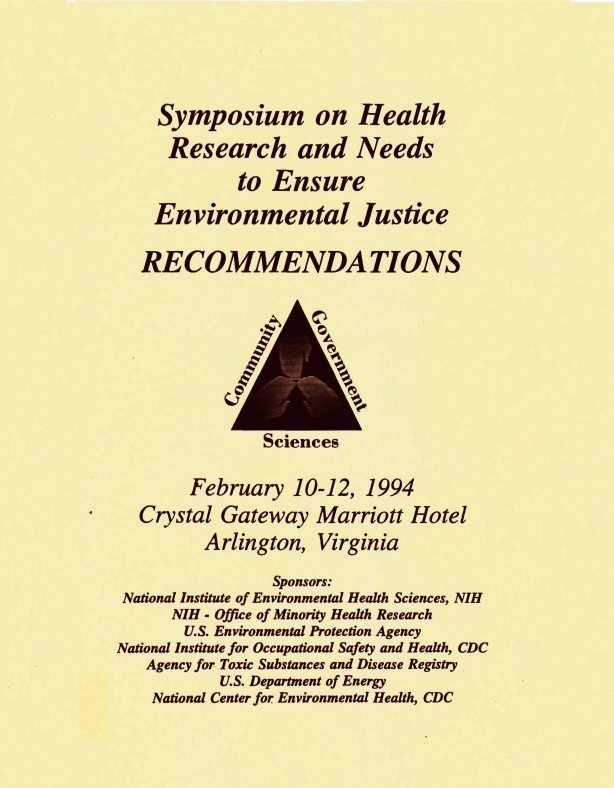
Held in Arlington, Virginia, this historic symposium brought together community leaders, grassroots organizations, labor, business, government, and academia to discuss strategies to improve the quality of life for vulnerable populations and environmental justice communities. Participants gathered in core groups to discuss meaningful and specific recommendations, which are embedded in the following categories: conduct meaningful health research; promote disease prevention and pollution prevention strategies; set up new ways for interagency coordination; provide outreach, education, and communications; and design legislative and legal remedies.
- U.S. House Representatives Authorize Funding for the Minority Worker Training Program
-
September 1994
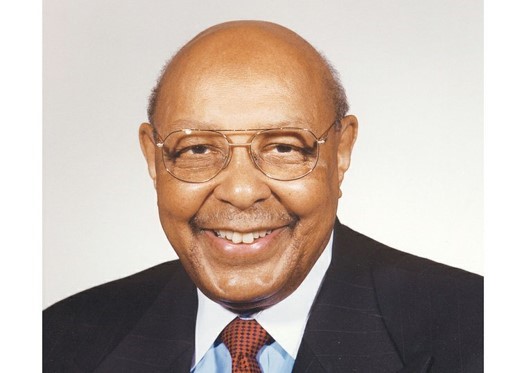 Congressman Louis Stokes, Ohio. (Photo courtesy of Sharon Beard, WTP)
Congressman Louis Stokes, Ohio. (Photo courtesy of Sharon Beard, WTP)The September 20, 1994, U.S. House of Representatives, Conference Report 103-311, authorizes $3,000,000 for the Minority Worker Training Program (now the Environmental Career Worker Training Program) and describes how the funds should be used and administered.
Related Links:
1995
- Environmental Job Training for Inner City Youth Workshop
-
January 1995
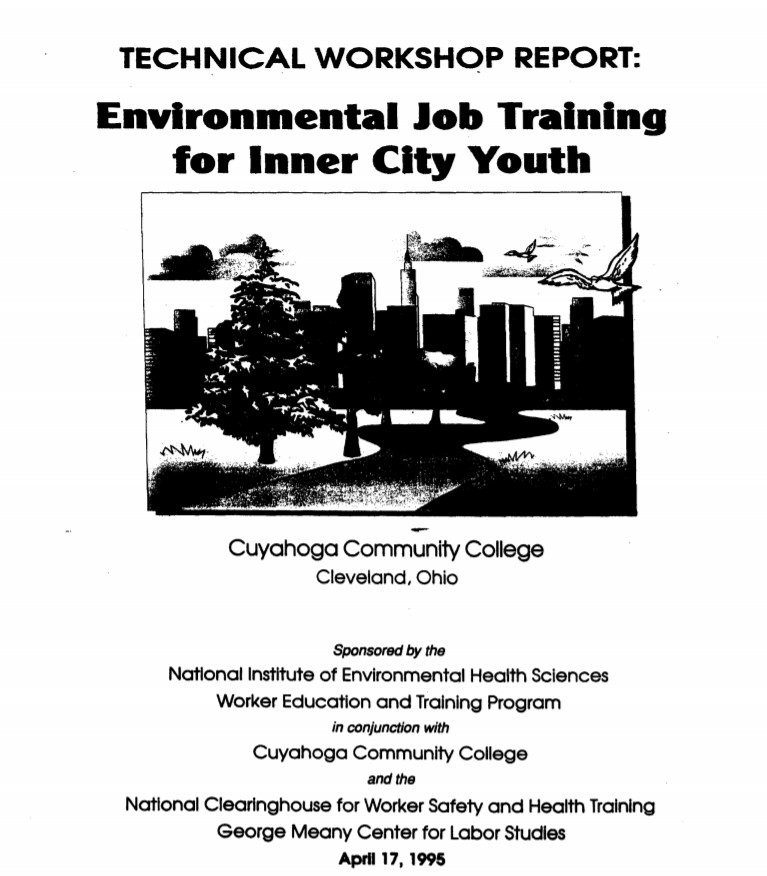
This NIEHS Workshop brought community groups and environmental justice advocates together with occupational and environmental health and safety training providers to discuss ways to implement and develop programs to help young urban minorities enter the environmental job market. The report, “Environmental Job Training for Inner City Youth,” summarizes key themes and messages from the workshop.
- Establishment of the NIEHS Minority Worker Training Program (MWTP)
-
September 1995
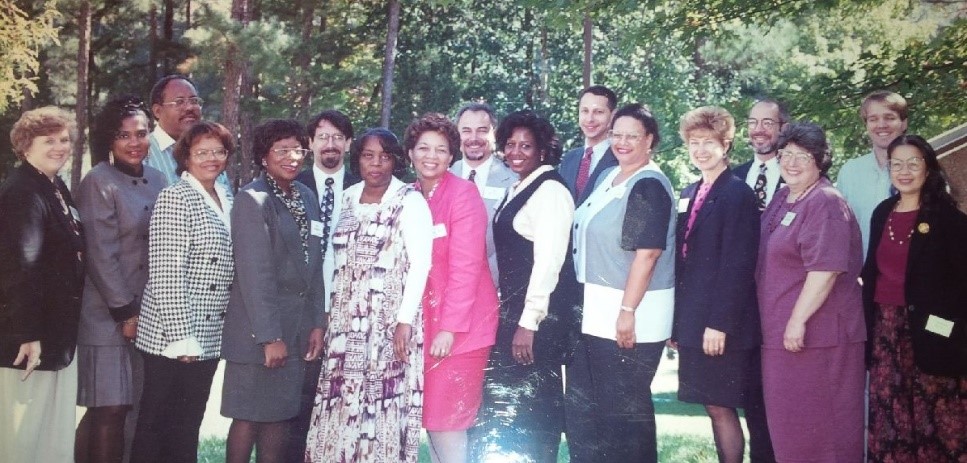 The first grantees of the NIEHS Minority Worker Training Program pose for a group photo after a meeting in 1995. (Photo courtesy of Sharon Beard, WTP)
The first grantees of the NIEHS Minority Worker Training Program pose for a group photo after a meeting in 1995. (Photo courtesy of Sharon Beard, WTP)The MWTP set out to support a series of national pilot programs through partnerships with academic and community-based organizations to test a range of strategies for recruiting and training people who live near hazardous waste sites or in communities at risk of exposure to contaminated properties in environmental remediation and construction workplace health and safety. The program strives to empower underrepresented minorities and other underserved people with health and safety training to increase their opportunities to gain employment in the construction and environmental remediation industries and to engage in community improvement efforts.
1998
- Brownfields: Hazmat Cleanup and More Report
-
April 1998
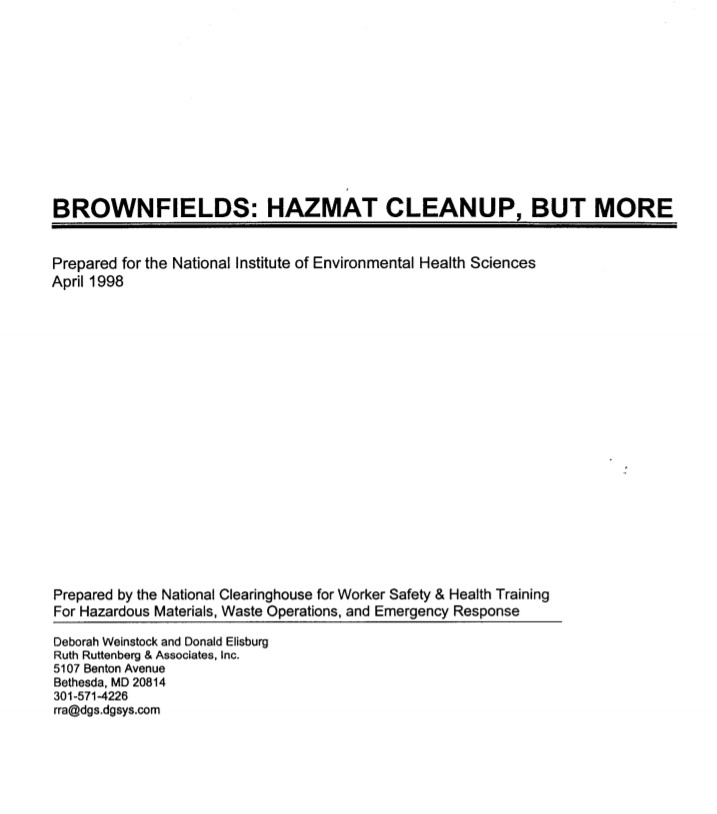
This report considers the impact of Brownfields initiatives on communities and how best to assure that impacted communities benefit from the redevelopment efforts, not only in terms of a nicer environment, but in terms of opportunities for personal growth, leading to continuous employment.
- NIEHS/EPA Brownfields Minority Worker Training Program
-
September 1998
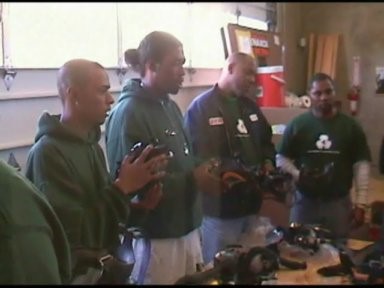 Trainees learning to use respirators as part of the Brownfields Minority Worker Training Program led by grantee CPWR – The Center for Construction Research and Training. (Photo courtesy of Sharon Beard, WTP)
Trainees learning to use respirators as part of the Brownfields Minority Worker Training Program led by grantee CPWR – The Center for Construction Research and Training. (Photo courtesy of Sharon Beard, WTP)Formed as a result of the Brownfields National Partnership Action Agenda, the NIEHS/U.S. Environmental Protection Agency (EPA) Brownfields Minority Worker Training Program was established in 1998. The program focused on delivering comprehensive training to disadvantaged residents living near brownfields sites to foster economic and environmental restoration of their communities.
2005
- Hurricane Katrina, NIEHS WTP Response
-
August 2005
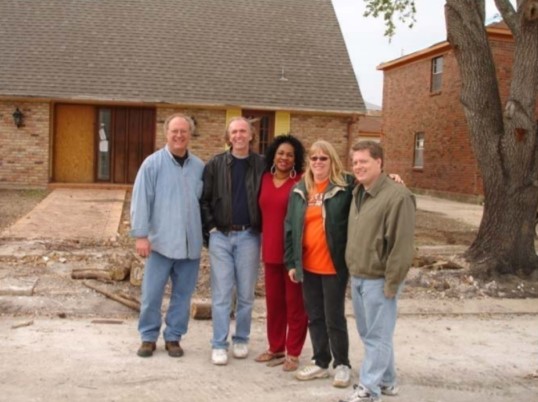 Beverly Wright, Ph.D., executive director of the Deep South Center for Environmental Justice (center), poses with other members of the Safe Way Back Home Team. (Photo courtesy of Beverly Wright, Ph.D., Building Safer and Resilient Communities in the Face of Climate Change presentation, April
Beverly Wright, Ph.D., executive director of the Deep South Center for Environmental Justice (center), poses with other members of the Safe Way Back Home Team. (Photo courtesy of Beverly Wright, Ph.D., Building Safer and Resilient Communities in the Face of Climate Change presentation, AprilHurricane Katrina made landfall on August 29 and caused widespread devastation and flooding in New Orleans, the U.S. Gulf Coast, and surrounding areas. NIEHS and EPA awarded job training grants to recruit and train local Gulf Coast residents affected by Hurricane Katrina.
ECWTP grantee the Historically Black Colleges Universities Consortium, (now co-led by Texas Southern University and the Deep South Center for Environmental Justice) partnered with WTP grantee the United Steelworkers to deliver training and facilitate clean-up in communities severely damaged by the storm. The team worked together to carve out a remediation plan as part of the Safe Way Back Home Project, a community cleanup project that facilitated restoration of a predominantly African American community in New Orleans. The community was not only restored, but made more sustainable, offering healthier living conditions for hundreds of families.
2007
- Toxics Wastes and Race at 20 Report
-
March 2007
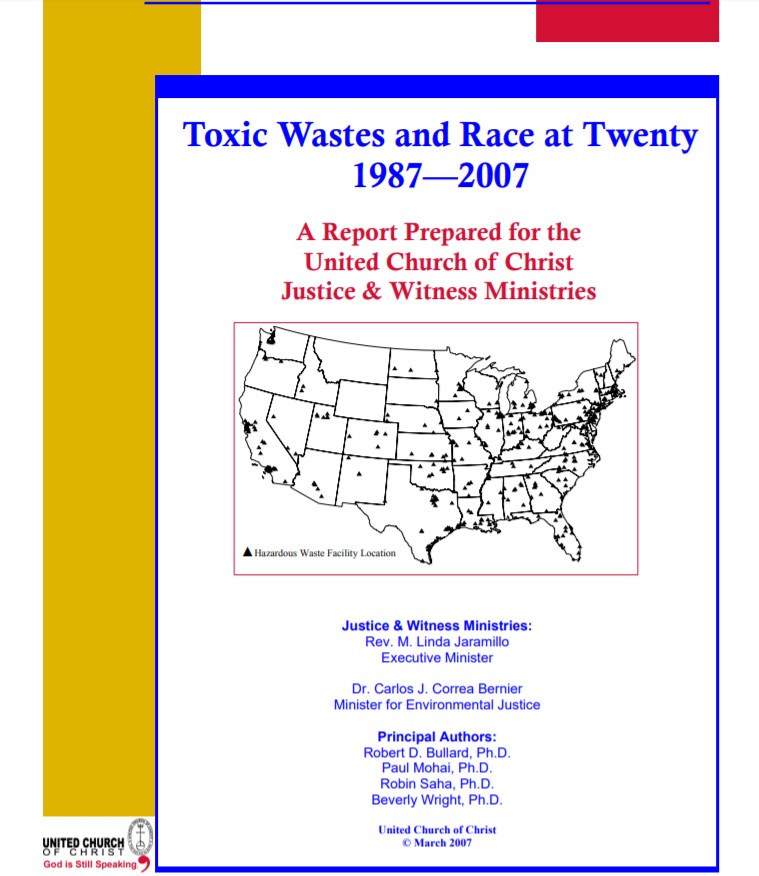
The United Church of Christ Justice and Witness Ministries commissioned a new report as part of the twentieth anniversary of the release of the 1987 report. Report reveals that racial disparities in the distribution of hazardous wastes are greater than previously reported, as people of color make up the majority of those living in close proximity to the nation’s hazardous waste facilities.
2008
- End of Brownfields Minority Worker Training Program
-
March 2008
The NIEHS/EPA Brownfields Minority Worker Training Program ended in 2008, but continued as part of the U.S. Department of Health and Human Services' commitment to the Brownfields National Partnership Action Agenda.
2009
- American Recovery and Reinvestment Act
-
February 2009
The American Recovery and Reinvestment Act (ARRA), also known as the Recovery Act, was signed into law by President Barack Obama in February 2009. ARRA was a stimulus package enacted by U.S. Congress in response to a nationwide economic crisis. The goal was to stimulate the economy through promotion of new and existing jobs and investment in long-term growth.
Funds from the Recovery Act supported a significant portion of training delivered by Minority Worker Training Program grantees between 2009 and 2014.
Related Links:
2010
- Conference on Environmental Justice, Air Quality, Goods Movement, and Green Jobs
-
January 2010
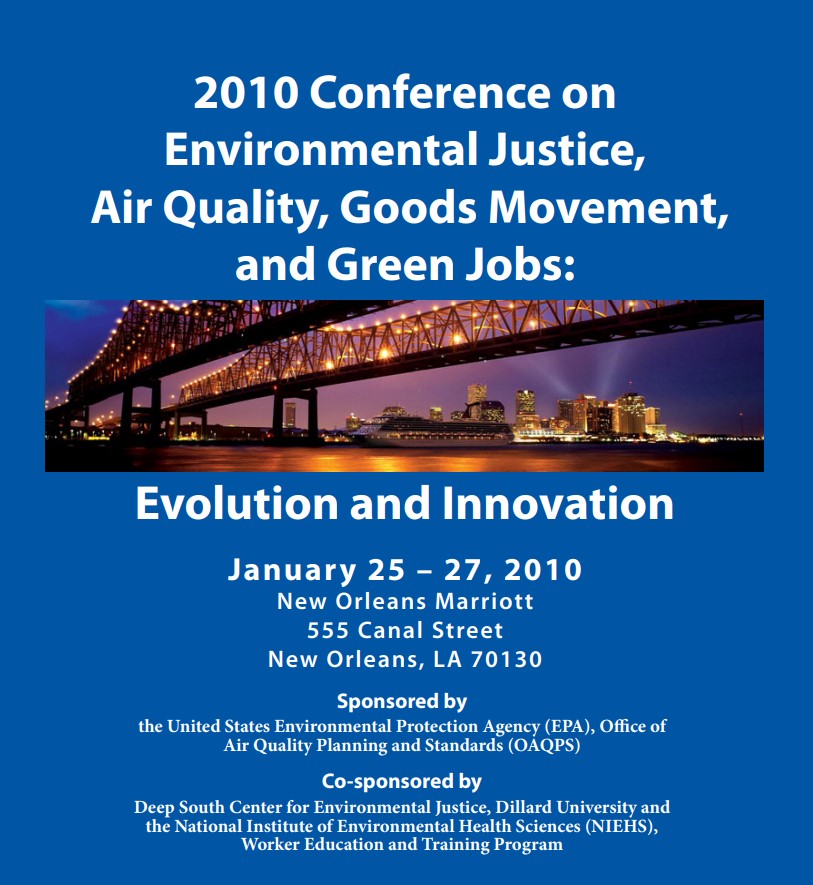
WTP partnered with the U.S. EPA and Dillard University to host the two-day conference in New Orleans, Louisiana. The conference focused on the movement of goods, ambient air and climate change, and hazardous waste cleanup. This generated a conversation on jobs of the future in sustainability and the renewable energy sector, and how it affects communities facing environmental justice issues.
- Deepwater Horizon Oil Spill, NIEHS WTP Response
-
April 2010
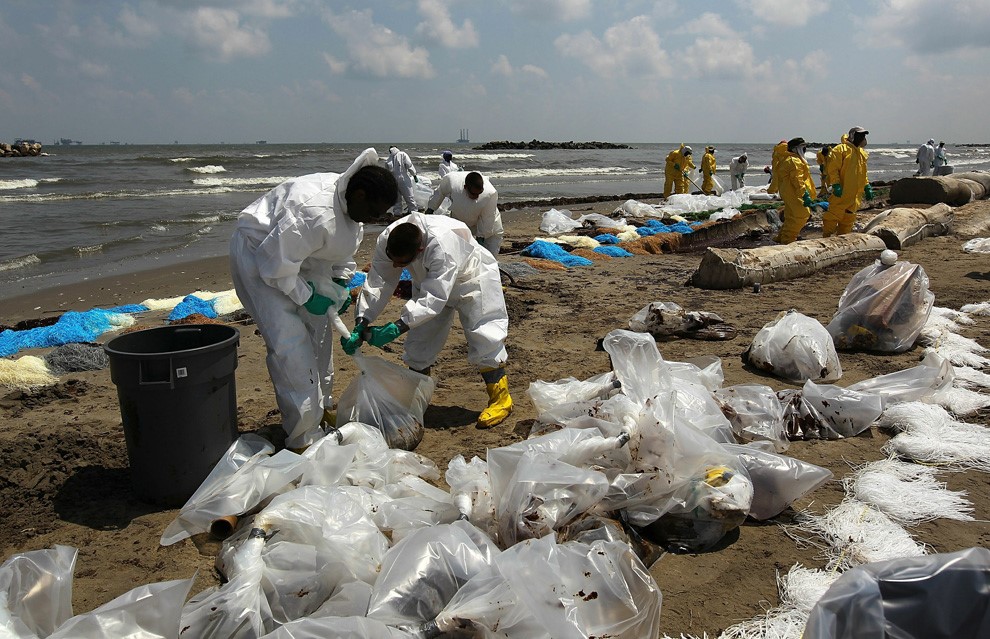 Workers helping with cleanup following the Deepwater Horizon Oil Spill. (Photo courtesy of the Deep South Center for Environmental Justice)
Workers helping with cleanup following the Deepwater Horizon Oil Spill. (Photo courtesy of the Deep South Center for Environmental Justice)The Deepwater Horizon Oil Spill took place – the largest oil spill recorded in the history of marine oil drilling operations – caused by an oil drilling rig explosion.
Within days of the oil rig explosion, WTP staff and grantees were on-site to train approximately 150,000 cleanup workers to protect their own health and safety while responding to the disaster.
ECWTP grantee the Historically Black Colleges Universities Consortium, responded to the call for training to equip workers to cleanup materials contaminated by the oil.
- 15 Years of Investment in Environmental Justice and Hazardous Waste Worker Training Programs
-
December 2010
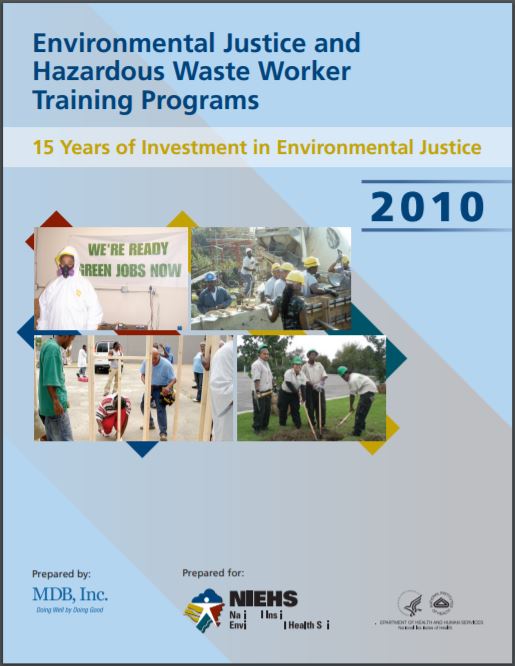
The report documents the implications and benefits of federal hazardous waste worker training programs in addressing environmental justice, in particular for the benefit of the residents of low income and minority communities. The report provides a brief history of these training programs, in particular the NIEHS WTP and EPA hazardous waste training programs; a statistical analysis of these hazardous waste worker training programs; and documentation of the benefits, best practices, and major findings based upon a literature review and expert interviews. This report also provides recommendations based on lessons learned and major findings on how these training programs could address environmental justice concerns and create green jobs even more effectively in the future, and how similar job training programs should be expanded to other Federal agencies.
2012
- Hurricane Sandy, NIEHS WTP Response
-
October 2012
Hurricane Sandy brought unprecedented storm surges and flooding to the northeast U.S. and left costly damages to communities in New Jersey and New York. Following the storm, local ECWTP grantees and trainees responded to help with clean-up activities. At the request of the World Cares Center, trainees from ECWTP grantee the Atlantic Center for Occupational Health and Safety worked to repair damaged homes as a part of a volunteer service-learning project.
2014
- Environmental Justice Milestones and Accomplishments (1964-2014) Report
-
February 2014
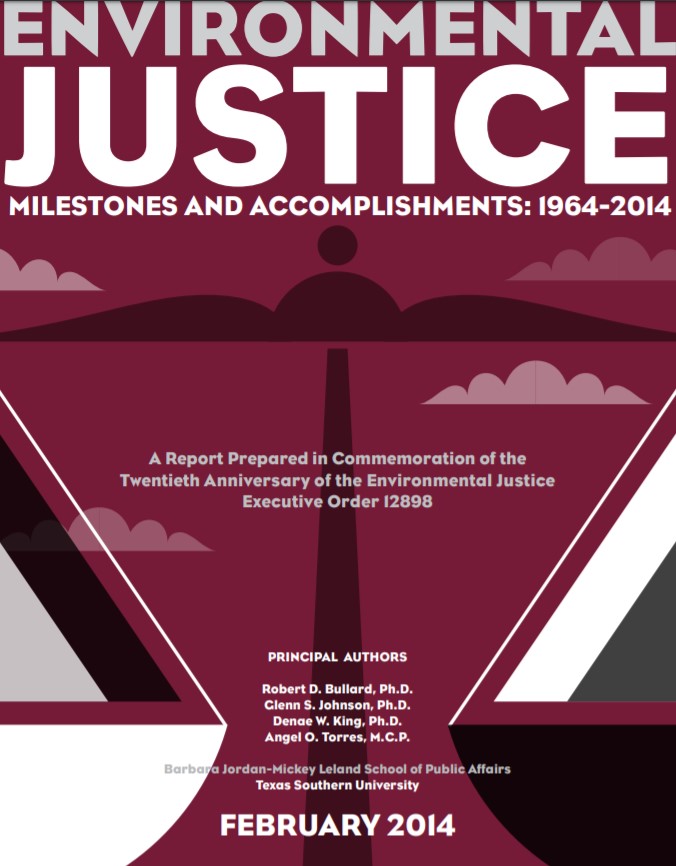
Environmental justice groups and coalitions from around the country gathered to commemorate the 20th anniversary of Executive Order 12898. As part of the anniversary, researchers at Texas Southern University released a report that chronicles milestones and achievements of the Environmental Justice Movement in the U.S.
- Minority Worker Training Program: Guidance on How to Achieve Successes and Best Practices Report
-
March 2014
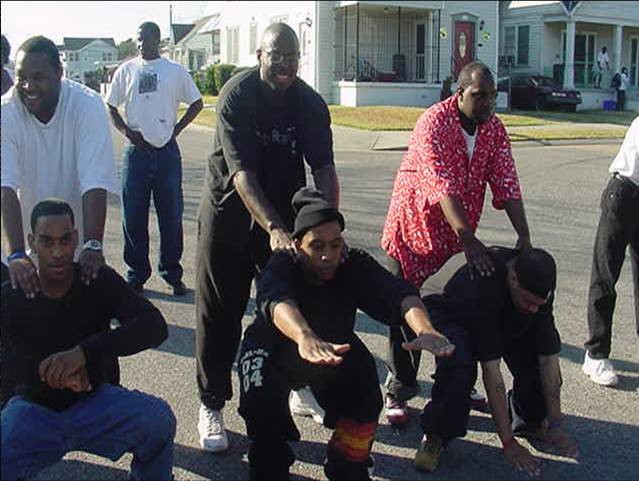 Group of trainees participating in a physical fitness training and exercise. (Photo courtesy of Sharon Beard, WTP)
Group of trainees participating in a physical fitness training and exercise. (Photo courtesy of Sharon Beard, WTP)This report summarizes best practices of the model implemented by the Minority Worker Training Program, focused on recruiting and training underserved and disadvantaged people for sustainable employment opportunities.
- Water Crisis in Flint, Michigan
-
April 2014
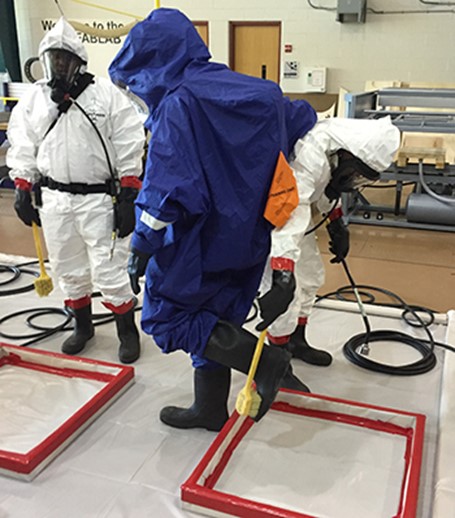 Trainees run through a simulation of a decontamination line in Flint, Michigan. (Photo courtesy of Howard Hipes, CPWR)
Trainees run through a simulation of a decontamination line in Flint, Michigan. (Photo courtesy of Howard Hipes, CPWR)Residents in Flint, Michigan began reporting issues with tap water in their homes. Studies confirmed elevated levels of lead in citywide water samples which were above the federal action level of 15 parts per billion.
ECWTP grantee, the Center for Construction Research and Training (CPWR), stepped in to help communities respond to the crisis in 2014. CPWR established a training program to help meet the need for a skilled cadre of workers who could replace unsafe water pipes.
2015
- The Economic Impact of the Environmental Career Worker Training Program Report
-
November 2015
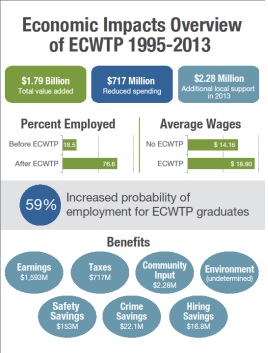 Infographic shows an overview of results described in the 2015 ECWTP Economic Impact report. (Photo courtesy of the National Clearinghouse of Worker Safety and Health Training, operated by MDB, Inc.)
Infographic shows an overview of results described in the 2015 ECWTP Economic Impact report. (Photo courtesy of the National Clearinghouse of Worker Safety and Health Training, operated by MDB, Inc.)In 2015, the Minority Worker Training Program was officially renamed the Environmental Career Worker Training Program. Later that year, the program released a report documenting a range of economic benefits from the ECWTP. Authors reported that fiscal benefits in the program’s positive effect on earnings also lead to additional revenue through taxes, reduced costs related to workplace injury, a reduction in hiring costs for businesses, decreased costs related to crime, and fewer social program transfers.
2020
- ECWTP 25th Anniversary
-
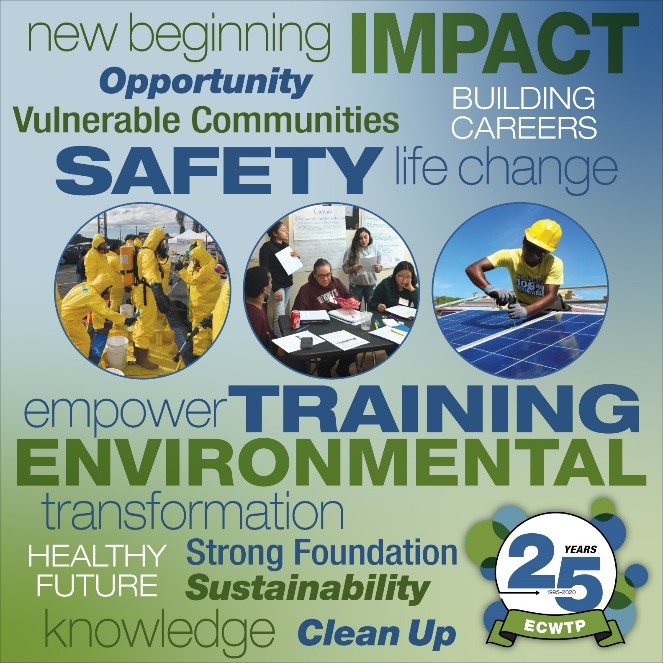 As a result of the ECWTP, individuals are empowered to transform their lives as well as the lives of others in their communities.
As a result of the ECWTP, individuals are empowered to transform their lives as well as the lives of others in their communities.
(Image courtesy of the National Clearinghouse for Worker Safety and Health Training, operated by MDB, Inc.)The ECWTP celebrates an incredible milestone. For 25 years, ECWTP has made enormous impacts on individual lives and communities across the nation. Since 1995, the ECWTP has reached thousands of underserved workers in more than 40 communities and 20 states.




